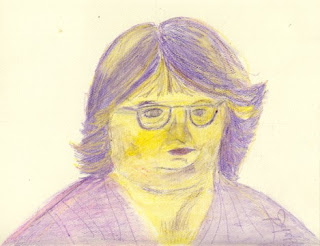Or Something is up up There!
The thought processes behind creating and living with your art.
Art happens in the head, not the hands. Anyone with enough manual dexterity to sign their own name has enough muscle control to draw, if sufficiently motivated.
Painting can be even easier. The basic skills of handling a pencil or paint brush, learning about color and color families, composition, etc. can be taught, even to a certain extent, creativity can be taught, or rather techniques for unlocking your own creativity can be discovered. These “keys” to creativity can and will be different for everyone.
But the main one is the same for all. The more you create, the more experience you get with the basic act of creating, the more in tune you will be with your own, unique creative process. And that happens inside your own head, not on a piece of paper or canvas.
Skill, don’t knock it.
Skill is required to successfully create any work of art. It just doesn’t “just happen”. Yes, there is serendipity in art. What other artists have called, “happy accidents” but you are more likely to have these happy accidents if you have mastered basic skills in whatever medium you have chosen.
This leads to:
Practice makes perfect in art as in everything else. The more you paint, draw, crave, mold, staple and manipulate any media, the more mastery you will have over it, and the more inventive you can get with it.
Guilt by Association
Another strange thing about creativity, the more you are around creative people, the more creative you become. This is the reality behind things like artist’s colonies. Creative people have found that by associating with other creative people the more creative they become.
Such is the reality of many of our art movements. The impressionists had their own little impressionistic “club” same with the Fauvists. Picasso did not create in a vacuum, he surrounded himself with an invisible and sometimes visible support to his creativity.
Which brings up to the art league, art association, artists group, etc. Many of us feel the need to join such groups. They can be a large influence on us or a drag, depending on how good they are at inspiring creativity. Some are great, other can drag you down. So you have to investigate and decide just how stimulating they will be to you, the artist.
Find a Mentor
 Ask yourself how will this group help you further your own artist ambitions? Do they encourage the work? Supply you with information or access to learning experiences? Do they sponsor the kind of shows that accept creativity or do they simply sponsor the same clickish work?
Ask yourself how will this group help you further your own artist ambitions? Do they encourage the work? Supply you with information or access to learning experiences? Do they sponsor the kind of shows that accept creativity or do they simply sponsor the same clickish work? Select carefully when it comes to learning experiences. Many “classes” are more social clubs. You do a selected, pre-thought out complete painting in an afternoon. These are fine for what they are, but they will not stimulate your own creative direction. Find a mentor.





